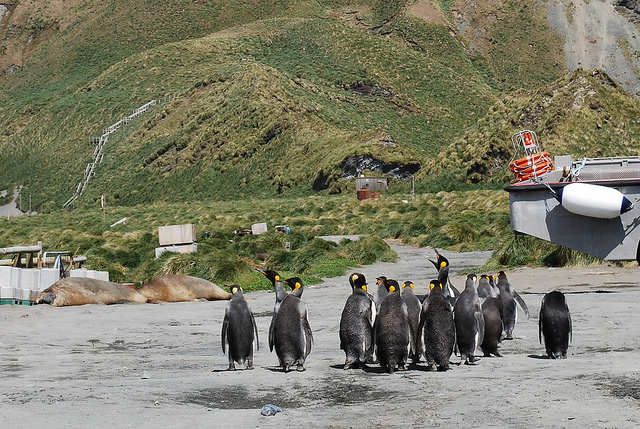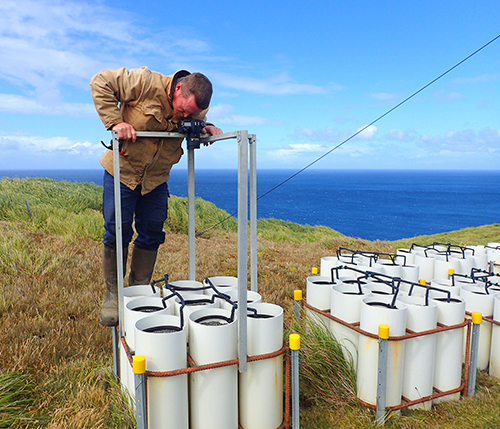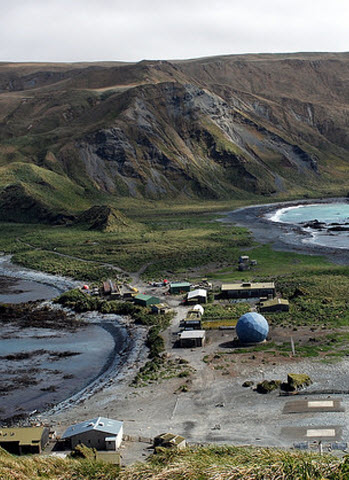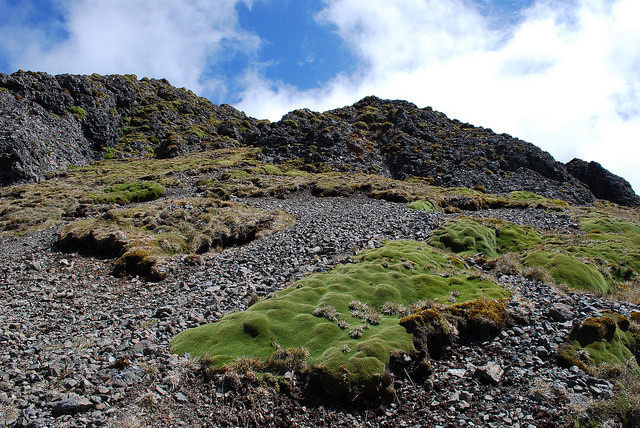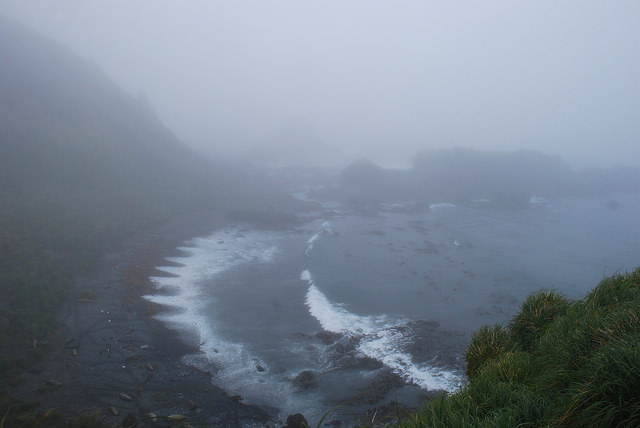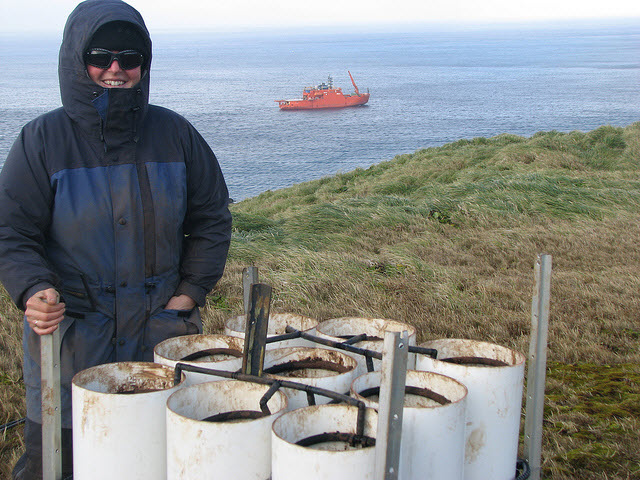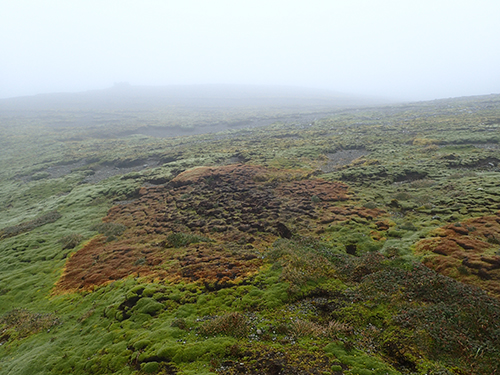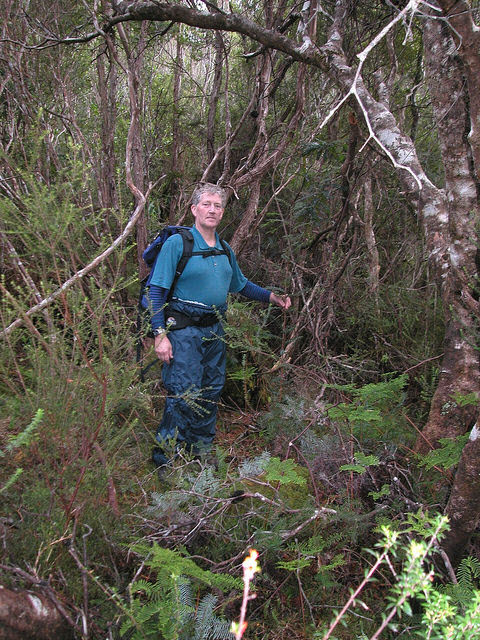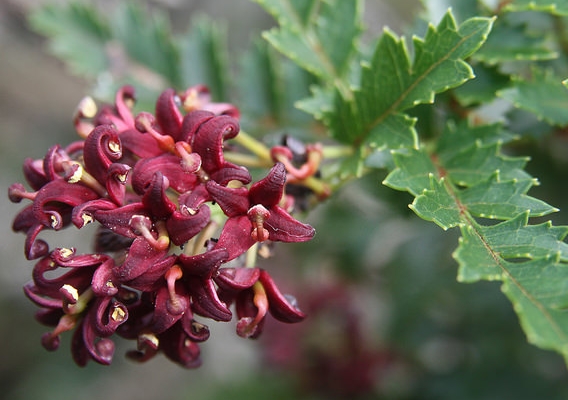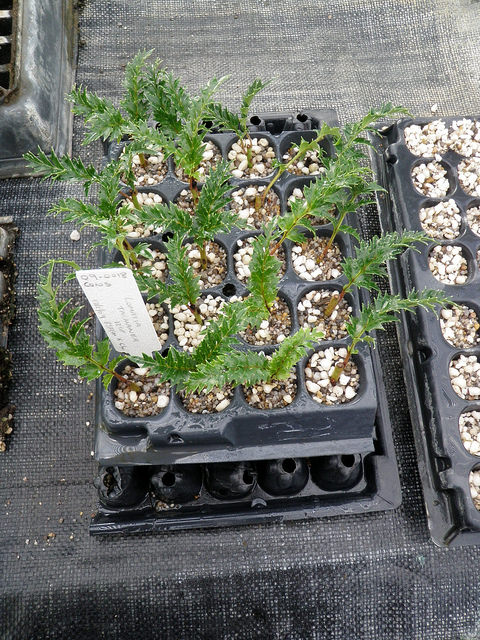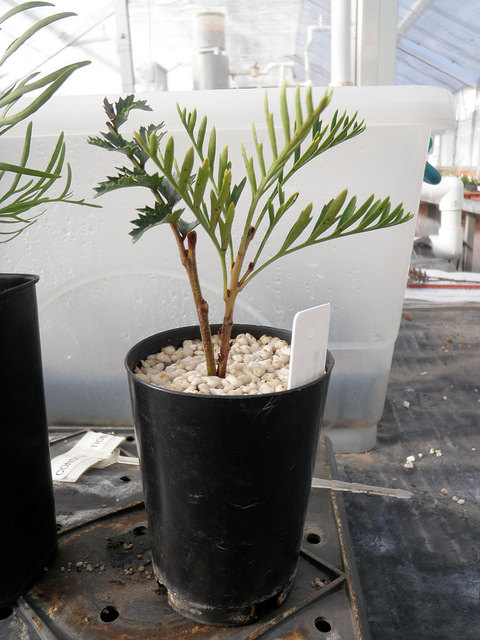
CONSERVATION PROJECTS
Work Within Tasmania
To date, the majority of the RTBGs’ involvements in project-based conservation initiatives have occurred via external funding and partnerships. TEMCO and the Tasmanian Minerals Council have provided, and continue to provide, funding for various Tasmanian threatened species programs. Other organisations contribute to similar programs via funding, support or in partnership including
- the Australian Flora Foundation,
- the Federal Government Envirofund grants program,
- Natural Resource Management (NRM) Tasmania,
- the Understorey Network,
- the University of Tasmania School of Plant Sciences and
- the Threatened Species Section (Department of Primary Industry, Parks, Water and Environment)

Environmental and Conservation Initiatives
Collections
A major part of the botanical gardens conservation work consists of ex-situ collections. The aim of these collections is to safeguard a representative sample of the genetic diversity of each population targeted. The ex-situ collections act as insurance against the loss of populations in the wild. Before 2005 the RTBG’s conservation programs largely consisted of potted collections of rare & threatened Tasmania flora. From 2006, with the advent of the Seed Conservation & Biology the RTBG’s ex-situ collections now primarily focus on the storage of seed collections.
Prior to the seedbank our ex-situ collections consisted of 128 individuals representing 20 threatened taxa curated by the gardens nursery. As of the 15th of May 2013 the seedbank holds 371 collections of 253 threatened taxa, totalling 9.5 million seeds.
The nursery now focuses it’s conservation efforts on those threatened species that do not set seeds Lomatia tasmanica and seed orchards of species difficult to collect directly in the field.
Seed Orchards
The Gardens maintains several species in potted ex-situ collections, for one or more of the following of reasons –
- some species do not produce viable seed,
- some species are being grown for re-introduction purposes,
- some are maintained for educational display purposes, and
- some are being grown as seed orchards for the Tasmanian Seed Conservation Centre
Of this last category, since 2007 the RTBG Nursery has grown 39 different species for seed orcharding, with 25 of the 39 being rare and threatened plants in Tasmania. Sixteen of these have been completed (ie. the seed has been successfully harvested and banked), 18 are still active and 5 are in propagation.
Some notable successes over the last six years include…
2008 Cyphanthera tasmanica (threatened & Endemic) – 16,000 seeds
2009 Phebalium daviesii (threatened & Endemic) – 34,700 seeds
2010 Boronia rhomboidea – 83,400 seeds
2011 Xerochrysum bicolor (threatened) – 455,300 seeds
2012 Australina pusilla ssp muelleri (threatened) – 527,200 seeds
2013 Mentha australis (threatened) – 29,100 seeds

National and Global Commitments
At a global level the RTBG is a member of the Botanic Garden Conservation International (BGCI) and is a signatory to the Global Strategy for Plant Conservation (GSPC). The GSPC 2010 targets outline our obligations and commitments relating to threatened plant species and biodiversity conservation, sustainable operational practices and education, and a commitment to working towards addressing the issues associated with climate change.
Climate change has created a major new challenge for botanic gardens worldwide, in 2008 the Heads of Australia’s Botanic Gardens and Herbaria from all States and Territories endorsed a National Strategy for Climate Change Adaptation by Australia’s Botanic Gardens. This Strategy outlines an agenda to develop a coordinated national perspective and increase the value and power of the role of botanic gardens in integrated plant and ecosystem conservation.
The RTBG is a member of SeedSafe, the Tasmanian partnership in the global Millennium Seed Bank Project (MSBP). The MSBP is an international seed conservation program coordinated by the Royal Botanic Gardens, Kew. In just under ten years the MSBP has secured 24,200 species from across the globe into long-term storage. SeedSafe established the Tasmanian Seed Conservation Centre at the RTBG and aims to collect and conserve 800 plant species native to Tasmania, and collect and conserve at least 60% of Tasmania’s threatened flora by 2010.

Seed Conservation & Biology
Opened in August 2005 the Tasmanian Seed Conservation Centre (TSCC) now plays a central role in the conservation work of the Royal Tasmanian Botanical Gardens.
Established as part of the international Millennium Seed Bank Project, the TSCC works to stop the loss of plant biodiversity within Tasmania and also conducts studies into the dormancy and germination behaviour of native seed.
To learn more about seed conservation, the activities of the TSCC and seed germination please browse through the pages listed in the side menu.
Germination data from our testing is available from the TSCC Germination Database.
-
Seed Banks & Conservation
In the following pages we discuss the role of botanic gardens in plant conservation and then look at how seed banking programmes can help in this work.
-
Seed Conservation in Tasmania
Tasmanian Seed Conservation Centre plays a central role in the conservation work of the RTBG. In the following pages we describe seed centre’s origins, it’s partners and what the seed centre does and why. We also provide a bit more background on the Germination Database.
-
Seed Germination
Every viable (living) seed has the potential to become a plant. For this to happen, the seed must germinate. But what is germination?
-
Seed Dormancy
The subject of seed dormancy has been actively researched for at least 100 years, and has been known to exist for far longer. However describing exactly what seed dormancy is can be troublesome.
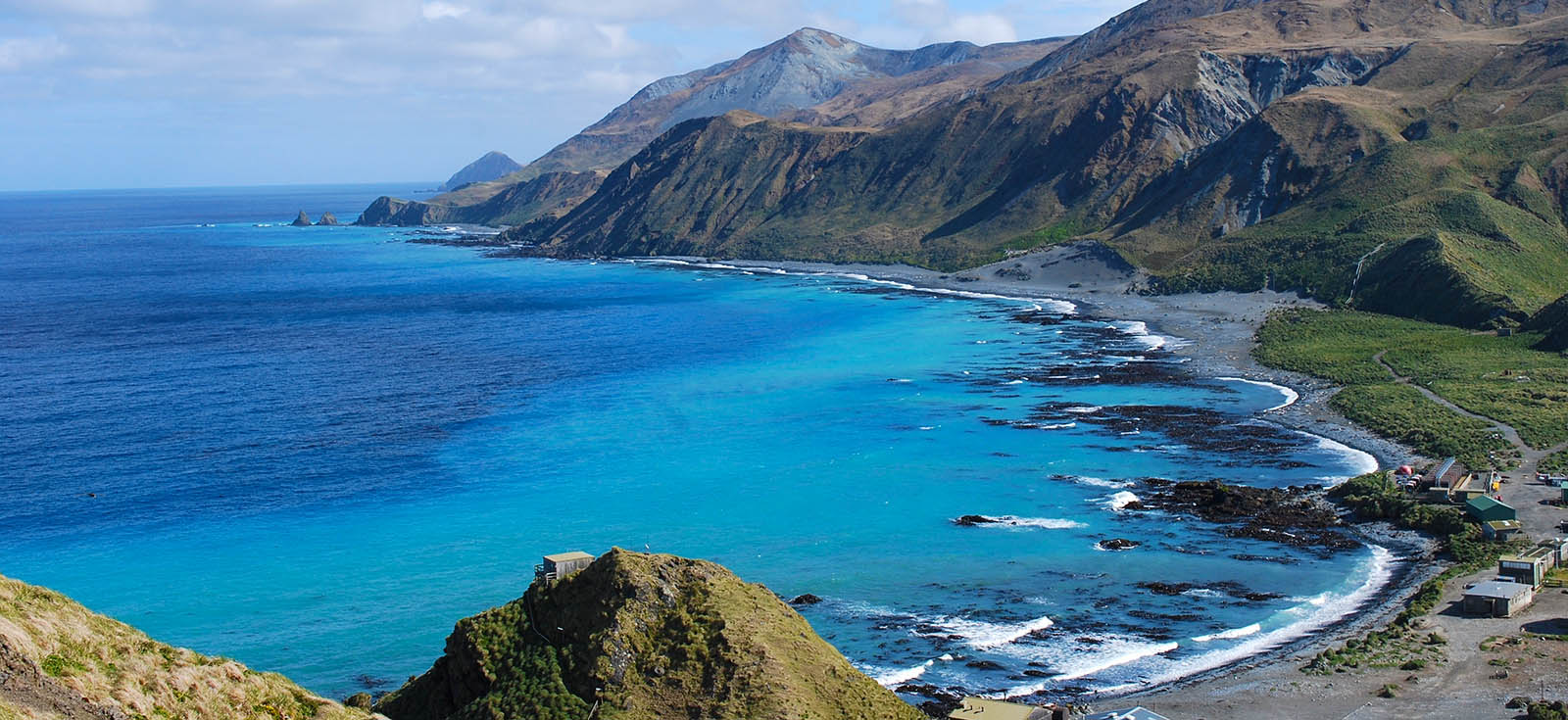
Azorella macquariensis
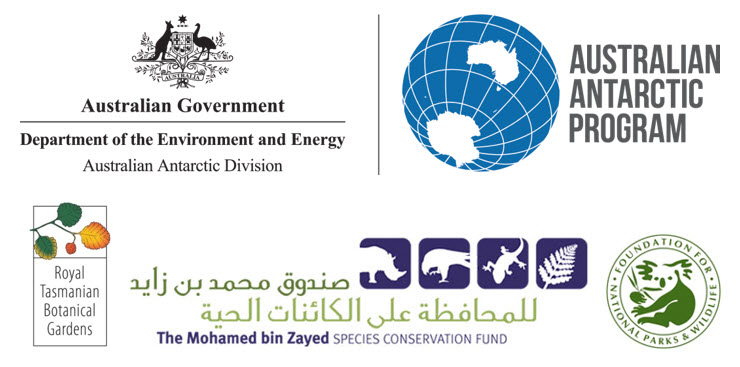
The Royal Tasmanian Botanical Gardens would like to acknowledge the Australian Antarctic Division for the ongoing support of this program and the various program sponsors over the years MORE DETAIL.
The Macquarie Cushion
Azorella macquariensis (Macquarie Cushion) is one of only four plants endemic to Macquarie Island. It is the dominant species of the feldmark, a plant community on the plateau uplands comprising of dwarf flowering plants, mosses, lichens, liverworts, interspersed with patches of bare ground. The feldmark covers 45% of the Island and A. macquariensis is considered to be a keystone species of this community.
Macquarie Island
Macquarie Island is a subantarctic Australian Territory managed by the Tasmanian Government Parks and Wildlife Service. It lies approximately 1,545km South Southeast of the Botanic Gardens and was inscribed on the World Heritage List in 1997 on the basis of its “outstanding natural universal values”. The entire island is approx 34 km long and 5 km wide and has been managed as a nature reserve since 1970.
Macquarie Island is unique in its origin in that it is a very rare example of recently uplifted oceanic crust formed around 11 million years ago. It is the only place on earth where rocks from the earth’s mantle are being actively exposed above sea level. Unlike other Subantarctic Islands, there are no active volcanoes or glaciers creating geological deposits on the island making its origin entirely oceanic.
Five plant communities have been identified on the island consisting of grassland, herbfield, fen, bog and feldmark. The vascular flora is small, consisting of 42 species and of these four are endemic – Azorella macquariensis, Puccinellia macquariensis (a grass) and two orchid species, Nematoceras dienemus and Nematoceras sulcatum.
Cushion Dieback
In late 2008, Dr Dana Bergstrom from the Australian Antarctic Divison (AAD) noticed large areas of cushions dying back or dying across the Island. Initial thoughts were that there was a disease spreading through the population, however subsequent extensive surveys and research work is indicating that the cause of the dieback appears to be multifactorial. A contributing factor may be a slight shift in climatic conditions occurring on Macquarie Island. The Primary Industries, Parks, Water & Environment’s (DPIPWE) Resource Management and Conservation Division plant scientists have been conducting a range of research projects on the island and a recently published example can be found at – http://dx.doi.org/10.1071/BT13207
The Royal Tasmanian Botanical Gardens has been involved in the conservation of this species since 2009 when a collection of plants and seed were brought back from the Island to hold as insurance and for research into the cause of the dieback.
Initial germination testing by the Tasmanian Seed Conservation Centre (TSCC) suggest that this species exhibits physiological dormancy .
As the RTBG facilities could not provide the strict quarantine conditions required to maintain the plants brought back from the Island, they were housed in a cool room facility at the Newtown Laboratories of DPIPWE. Creating the environmental conditions required to maintain this species long-term is difficult and expensive, therefore the decision was made to develop a potted conservation collection on Macquarie Island itself.
Horticulture on Macquarie
In March 2010 Michelle Lang (then RTBG Nursery Supervisor) travelled down to Macquarie Island to set up a trial potted conservation collection. The plants were potted into 800mm long plastic pipes to provide perfect drainage, as well as protection from rabbits and potential soil pathogens. All plants were provided with an automated watering system operated by a rain sensor.
Fortunately all nine plants settled well into their high rise lifestyle and plans were later developed for an on-Island ex-situ conservation collection, consisting of 54 individual plants collected from wide ranging populations across the Island. This collection also serves as a seed orchard, where individual plants may be cross-pollinated to hopefully enhance seed-set and broaden the genetic make-up of the seed collected.
Images of each plant are taken by the Tasmanian Parks and Wildlife Rangers (TASPWS) on Macquarie Island each month during the growing season and sent to RTBG staff to closely monitor their health. Comparative images show good growth rates, proving this as a successful method of ensuring the conservation of this species.
Lomatia tasmanica
A Tasmanian Icon
The genus Lomatia of the family Proteaceae, has a southern hemisphere distribution with nine species occurring in Australia and three in South America (Wilson et. al. 1995). Of the Australian species, three are endemic to Tasmania, two of which are widespread throughout the state, and one, Lomatia tasmanica, restricted to a single population of less than 500 stems in the southwest. At the state level, it is listed as endangered under the Tasmanian Threatened Species Protection Act 1995 and federally as critically endangered under the Commonwealth Environment Protection and Biodiversity Conservation Act 1999.
Its common name, King’s Lomatia is derived from tin miner and local naturalist, Deny King, who first found the species growing in 1934 (Lynch & Balmer, 2004). It was only formally described by Dr Winifred Curtis of the Tasmanian Herbarium in 1967, two years after the King family collected a flower from the wild. It occurs along creek lines in mixed forest with a canopy of Eucalyptus nitida(Smithton Peppermint) over rainforest elements such as Nothofagus cunninghamii (Tasmanian myrtle) and Phyllocladus aspleniifolius (celery top pine) with an understorey of sclerophyllous shrubs, ferns and mosses.
Lomatia tasmanica grows as a shrub or small tree of 5 to 8 metres in height with broad leathery divided leaves and produces clusters (racemes) of waxy burgundy flowers at the ends of the branches.
Threats to Lomatia
Mature fruit and seed have never been found in cultivation or the wild and this is most likely due to the triploid nature of the clone, making it sterile. Lynch et al. in 1998 found no genetic diversity in a study of 78 plants from the population. Investigation of the chromosome number showed it to have 33 chromosomes compared to the normal diploid number of 22 found in other Lomatia and the Tasmanian species, Lomatia tinctoria also investigated in the study.
Fossil leaves of Lomatia tasmanica found in southwest Tasmania were dated at 43,600 years old (Jordan et al. 1991) and given that the plant is a clone and has only been able to reproduce vegetatively by rhizome, it is one of the oldest living plant clones in the world.
Like many members of the Proteaceae family, Lomatia tasmanica is susceptible to Phytophthora cinnamomi root rot and the disease has been found within 20m of the first plant in the wild population (Dr Tim Rudman in Threatened Species Section, 2006). This was evident in a field trip the RTBG participated in 2005 to collect propagation material to build up the ex-situ collection. There were many dead and dying banksias across the buttongrass plain adjacent to the wild population and standard practice by government agencies and researchers is to use a footbath to disinfect shoes and equipment before entering the area. In fact so great is the risk of disease reaching the wild population, and causing its ultimate extinction, that the plant enthusiasts seeking to view the natural population are actively discouraged from doing so, as it is only accessible for essential purposes and includes stringent quarantine regulations. Anyone wanting to see a plant of Lomatia tasmanica is encouraged to contact either the Friends of the RTBG or the RTBG directly to arrange a viewing of the RTBG collection.
Another threat to the species is an increased incidence of fire (Lynch & Balmer, 2004). Lomatia tasmanica will regenerate vegetatively following fire and many of the extant plants date from a 1934 fire, however some stems predate this (Lynch & Balmer, 2004). An increase in the incidence of firing may not allow the population to re-establish between fire events, and an increase in the ferocity of fire could result in the death of all stems. The population is restricted to an area of only 1.2 km (Lynch et al., 1998), and fire would also open up the vegetation, increasing the chance of infection by Phytophthora root rot at the site (Podger et al.,1990).
A further threat to the future survival of Lomatia tasmanica is climate change. Jayne Balmer (2009 in press) surveyed the population in both 1993 and 2008 and noted a decline in stem numbers. Given the difficulty of surveying in the poor light and tangled understorey below the rainforest canopy, Balmer found there was a real decline in numbers of between 18% and 32% over the 14 year period. Loss was mainly in the small stems. Possible causes suggested were reduced light level as the rainforest canopy had closed over following the last major fire in1934, build up of litter and wood debris and competition from groundstorey species. Analysis of the rainfall data for the period showed that rainfall in the 14 years previous to the study at the nearest weather station at Maatsuyker Island was almost 500mm higher per year than during the study period. The experience in cultivation at the RTBG has shown that Lomatia tasmanica is extremely susceptible to changes in moisture and humidity, with rapid death following display indoors. Balmer noted loss in the wild population was in loose clusters, rather than across the area surveyed, and suggested that this sensitivity to changes in moisture and humidity may have led to the decline in the wild with the decreased rainfall.
Challenges of ex-situ conservation
In-situ protection of the population is of highest importance as outlined in the Department of Primary Industries and Water Flora Recovery Plan 2006-2010, but the establishment of an ex-situ collection provides some insurance against possible loss in the wild. The RTBG has worked in collaboration with the Threatened Species Section of the Nature Conservation Branch with the aim of securing a conservation collection of 50 plants. The first material for this target was collected by RTBG staff member Mark Fountain from the wild population in 1994. Propagation, given the failure of the species to produce seed, was from cuttings, and this has been the main method of producing new plants to the present day.
Over time cutting propagation has been refined and semi-hardwood tip and stem cuttings dipped with Clonex Purple® have been found to produce the best results. Cuttings are generally taken in January and February and placed in a 50:50 perlite and washed river sand mix and placed under mist, raised slightly above bottom heat. They can take up to 12 months to root and have a strike rate of between 60% and 80%. Leaf cuttings have been trialled, and while they produce roots, only one has ever produced a shoot. Whilst the strike rate is reasonably good, Lomatia tasmanica resents root disturbance, and major losses occur when potting on. To overcome this, in part, the cuttings are originally placed in individual potting cells, rather than punnets.
Problems still exist when potting on to tubes and larger pot sizes and this combined with the sensitivity to changes in moisture and humidity make it very difficult to maintain in pot culture. An example of the sensitivity to root disturbance can be seen in the loss of the last plant propagated in 1994, which survived potting on over time to a 20” pot, but died following disturbance to the surface soil to remove a coating of liverworts in 2007. At present the oldest surviving plant from propagation in 1998 is about 1.5m tall.
As well as being tricky in pot culture, Lomatia tasmanica has also proven even more difficult to maintain in the ground. Only specimens that have been grafted on to a rootstock of another Tasmanian species, Lomatia tinctoria, have survived in the ground. The grafting technique was developed by local nurseryman Ken Gillanders who has used a side wedge graft. Grafting is done in February with cuttings of 3 to 4 buds of both species. The graft union is placed below the mix, which is the same as used for traditional cuttings. One of the problems has been matching the size of the scion and rootstock and the RTBG will trial the Chilean species Lomatia ferruginea, as a potential root stock.
A major problem in securing an ex-situ conservation collection of Lomatia tasmanica has been the paucity of material for propagation. As the species is a clone, it is an ideal candidate for proliferation in tissue culture propagation. One advantage of using tissue culture is that large numbers of plants can be produced from small amounts of material once a species has been successfully established in vitro. It has been noted in the RTBG nursery that the leaves of Lomatia tasmanica invariably blacken off shortly before the plant dies and this is due to a build up of phenolic compounds in the tissue. This can be a response to injury and has been an ongoing problem with proteas in the cut flower industry (Reid et. al.1989, Bieleski et. al. 1992). Unfortunately this has also been a big problem in the work RTBG staff Alan Macfadyen and Natalie Tapson carried out on the tissue culture propagation of the species. Research has been undertaken in collaboration with Anthony Koutoulis and Aina Price of the Plant Science Department of the University of Tasmania since late 2004. Cut stems immediately blacken off when material is cut for explants and this increases during disinfestation prior to tissue culture.
Various treatments have been trialled to overcome this with an incremental improvement in survivorship in vitro. This work has generally been done in August when the material on the plants is relatively soft and before flowering occurs. Unfortunately, this program was discontinued by UTas in 2019.
Investigating Pollen Viability
Plants of the genus Lomatia produce a leathery follicle but no fruit has ever been recorded in Lomatia tasmanica in cultivation or in the wild. The flowers of Lomatia species are protandrous, the pollen is released from the anthers before the stigma becomes receptive, and this promotes out crossing between individuals. RTBG staff Lorraine Perrins and Lizzie Ziegler carried out a pollen viability trial in December 2008.
The pollen was removed from the stigma of recently open Lomatia ferruginea flowers and Lomatia tasmanica pollen was placed on the stigmatic surface and the flowers were bagged. Follicles had developed on two of the flowers in May 2009 and germination testing undertaken by James Wood of the Tasmanian Seed Conservation Centre has resulted in the germination of 3 out of 9 seeds. These were grown on to see if hybrids have been generated, however, proved unsuccessful.
The Future for Lomatia
The RTBG has a target to hold 50 plants of Lomatia tasmanica in an ex-situ conservation collection and will continue to build on this. The threats facing the species in the wild are very real, with the proximity of Phytophthora root rot to the population, the most pressing at present. As stated, the lack of material for propagation continues to be a problem and the annual nursery propagation cycle will be ongoing to ensure that the target number is maintained.
For further information on Lomatia tasmania http://dpipwe.tas.gov.au/Documents/Lomatia-tasmanica.pdf or email: rtbg@rtbg.tas.gov.au
References
Balmer J (2009) An estimate of change in a subpopulation of Lomatia tasmanica (Proteaceae) between 1993 and 2008. Papers and Proceedings of the Royal Society of Tasmania 143, in press.
Bieleski RL, Ripperda J, Newman, JP & Reid MS (1992) Carbohydrate Changes and Leaf Blackening in Cut Flower Stems of Protea exima. Journal of the American Society of Horticultural Science117(1):124-127.
Jordan GJ, Carpenter R J & Hill RS (1991) Late Pleistocene Vegetation and Climate near Melaleuca Inlet, South–western Tasmania. Australian Journal of Botany 39, 315-333.
Lynch AJJ & Balmer J (2004) The ecology, phytosociology and stand structure of an ancient endemic plant Lomatia tasmanica (Proteaceae) approaching extinction. Australian Journal of Botany 52, 619-627.
Lynch AJJ, Barnes RW, Cambecedes J & Vaillancourt RE (1998) Genetic Evidence that Lomatia tasmanica is an Ancient Clone. Australian Journal of Botany 46, 25-33.
Podger F, Palzer C & Wardlaw T (1990) A guide to the Tasmanian distribution of Phytophthora cinnamomi and its effects on native vegetation. Tasforests 2(1), 13-20.
Reid MS, van Doorn W & Newman JP (1989) Leaf Blackening in Proteas. Acta Horticulture 261, 81-84.
Threatened Species Section (2006) Flora Recovery Plan: King’s lomatia, Lomatia tasmanica 2006-2010. Department of Primary Industries, Water & Environment, Hobart
Wilson AJG, Hewson HJ & Mowatt J. Lomatia, Flora of Australia16:374-382 (1995).
Hardenbergia violacea
In Tasmania however, Hardenbergia violacea is an uncommon, sprawling under shrub which is listed as endangered on the Tasmanian Threatened Species Protection Act 1995.
DNA research has identified that the Tasmanian form is genetically distinct from the more common mainland forms (Larcombe 2006), and the Tasmanian form is less vigorous than cultivated mainland garden varieties tending to be more prostrate and the flower colour more intense.
The Tasmanian Hardenbergia is only known to occur in one area on the Pontos Hills near Hobart, growing on Triassic sandstone outcrops, at altitudes of 105 to 125 m above sea level. The population has a linear range of less than 400m, scattered over an area of 1.8 ha.

Seedpod of Hardenbergia violacea.
One sub-population occurs on private land which has been placed under a conservation convenant. A second sub-population 1.7km to the south is now considered to be extinct. The main threats to this species in the wild are drought and browsing pressures. Fortunately the Royal Tasmanian Botanical Gardens (RTBG) managed to secure 7 genotypes from the southern population prior to its extinction which were maintained at the RTBG as a “seed orchard” for seed production. Propagation material from several genotypes from the northern population were also collected and used as seed orchards.
The RTBG safeguards this species as a seed collection at its Tasmanian Seed Conservation Centre (TSCC), and at its partner institute the Millennium Seedbank at the Royal Botanic Gardens Kew, UK. Between 2008-2014 the RTBG harvested a total of 17,770 seeds from the Hardenbergia seed orchards. Over 8,000 seeds were harvested from the extinct population genotypes and the opportunity to pollinate across the two subpopulations and harvest seed with a potentially broader genetic diversity was also actioned, resulting in 6,000 seeds.
Building Resilience for the Future Stability of Hardenbergia violacea in Tasmania
In 2010 the Penna Landcare Group were awarded a Tasmanian Landcaring Grant from the Tasmanian Landcare Association to ‘Develop an in-situ sub-population of Hardenbergia violacea at Pontos Hills’ and volunteers from Threatened Plants Tasmania assisted staff from the Biodiversity Unit of DPIPWE, and the RTBG to augment the wild northern-most population. This involved the addition of 76 RTBG nursery grown plants to an unpopulated site on Pontos Hills.
As browsing by native animals was considered a major threat to the success of any plantings all the plants were enclosed within 3 rabbit and possum proof fenced areas. Working in difficult steep, rocky terrain, the hard-working team managed to complete the project in 2 days. Closely monitoring the translocated plants over the succeeding years, we have been pleased with the survival rate despite the extreme drought conditions in 2015.
The RTBG acknowledges the generous assistance from the then Landowner, Tony Scherer; Rob Walker and the Penna Landcare Group; Anne Thwaites, Ken Wright, Oliver Strutt and Nell Hilliard from Threatened Plants Tasmania; and Mick Illowski, Oberon Carter and Richard Schahinger from DPIPWE, in completing this project.

Davies Waxflower
Discovery
Davies’ Waxflower (Phebalium daviesii) is slender shrub endemic to Tasmania’s north east coast. Known from only three collections made around the St. Helens area back in late 1800’s, it was believed to be extinct. But in 1990 a population of 55 plants was rediscovered on the Georges River by fern expert Michael Garrret. Recognised and listed as critically endangered in the wild, in 1995 a joint party of RTBG and DPIPWE staff visited the population to collect cutting material. The cuttings were passed on to the RTBG Nursery where 26 individuals from the original population were successfully established. (DPIPWE), also HERE, and listings page HERE
Safeguard
Sadly since collecting took place, erosion from flooding and storm damage has reduced the wild population to less than 20 individuals. However over time the collection in the nursery has grown to 40 individuals as the plants began self seeding around the nursery. Knowing the plants were setting good seed attempts were made to collect it, but these largely met with failure. “Getting a seed collection would further safeguard the diversity we’re holding, but we initially had problems” comments Lorraine. “It’s not really obvious when the fruit are ripe, we also didn’t realise how small the seeds are or how explosive the dispersal mechanism is. It’s meant that the conventional method of catching fallen seed in trays below the plants was just ineffective”.
Summer Harvest
So in Spring of 2008 nursery staff decided a more thorough approach was required. Nursery Supervisor Michelle Lang constructed purpose built hessian bags to enclose completely 45 of the larger plants held in the nursery (representing 32 individuals). After flowering was completed the bags were fitted around the plants with the hope of capturing any seed that might develop. In the middle of January 2009 the bags were carefully removed from the plants and the contents (a mixture of old leaves, flowers and fruit debris) poured into trays. The material was then passed over to Tasmanian Seed Conservation Centre coordinator James Wood for cleaning.
James says “Lorraine and I had a sneak peak at one of the bagged plants back in the middle of December to see what was going on. We recovered 95 seeds which was very encouraging as the previous years total collection was only 85 seeds. With 45 plants bagged up we were confident that we’d have a collection of at least 4 to 5 thousand seeds.”

The Next Challenge
Back in Hobart the seed has been safely stored away and for James the real work begins. “Now we have the Phebalium banked I’ll have to determine how to germinate it and that will not be easy.” he says. In fact studies have shown that Phebalium like a lot of other Australian Rutaceae are actually extremely difficult to germinate. “The cut test shows the seed we collected is good. We know that they can germinate as we’ve had a few seedlings turn up under benches in the nursery. The sobering thing for me is that the nursery plants have more than likely been dispersing tens of thousands of seed each year, but we’re only seeing one or two seedlings pop up every few years.” James will need to do a lot better than that. “I need to be able to get over 75% germination on a test sample before I can say my initial work on this collection is complete. That’s going to be tough.”
Fortunately a seed collection of this size allows the opportunity for research work to be carried out. “Wild plant species are often difficult to germinate” says James “Typically they can require a quite specific series of conditions to trigger germination.” For seed banks with a small collection only a small percentage of seeds can be used in germination trials. “A big collection gives us the chance to run a really wide range of tests and gives us a greater opportunity to identify and confirm the important triggers. I expect to get into testing this spring. It’ll be interesting, but I’m ready for a long hard slog to get this to pass” he says.
The germination trials aren’t just an academic endeavour. By understanding the germination requirements seed can be turned into plants and new individuals can be returned to the population. If germination is understood then seed longevity research can also be conducted. By understanding these two traits conservationists can make better evaluation as to the health of the population. As James explains “By understanding how long seeds can last and how they germinate we may be able to better manage sites to encourage seedling recruitment. That information is important for conservation workers in the field.”
Luke’s Cemetery
Podolepis jaceoides flowering at St. Lukes Cemetery, Bothwell. Cemeteries like St. Lukes are an important refuge for many grassland species that once dominated the Tasmanian Midlands landscape. This fragment of native grassland is home to a number of threatened plant species.
Remnant Grassy Treasures

RTBG Tasmanian Seedbank coordinator James Wood collecting Leptorhynchos elongatus at St. Lukes Cemetery, Bothwell.
Collaborating for Conservation
The RTBG has worked with the Municipality of the Central Highlands Council to help conserve a fragment of native Themeda triandra (Kangaroo Grass) grassland at St. Lukes Cemetery in the midlands township of Bothwell. A number of rare and threatened plant species are found at this site including the endangered daisy Leptorhynchos elongatus (Lanky Buttons) which is found in just three other locations in the state. Funding acquired through the Midlands Biodiversity Hotspot Project has enabled council to recruit the services of the Gardens to assist with the management of this precious natural resource and its important conservation values.

